Helladic chronology
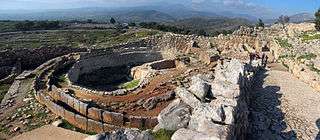 | |
| Period | Bronze Age Europe |
|---|---|
| Dates | c. 3200 BC – c. 1050 BC |
| Major sites | Thebes, Tiryns, Mycenae |
| Preceded by | Neolithic Greece |
| Followed by | Greek Dark Ages |
Part of a series on the |
|---|
| History of Greece |
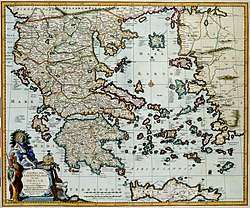 |
|
History by topic |
|
|
Helladic chronology is a relative dating system used in archaeology and art history. It complements the Minoan chronology scheme devised by Sir Arthur Evans for the categorisation of Bronze Age artefacts within a historical framework. Whereas Minoan chronology is specific to Crete, the cultural and geographical scope of Helladic chronology is mainland Greece during the same timespan (c.3200–c.1050). Similarly, a Cycladic chronology system is used for artefacts found in the Aegean islands. Archaeological evidence has shown that, broadly, civilisation developed concurrently across the whole region and so the three schemes complement each other chronologically.
The systems apply primarily to pottery, which is a benchmark for relative dating of associated artefacts such as tools and weapons. On the basis of style and technique, Evans divided his Cretan Bronze Age pottery finds into three main periods which he called Early, Middle and Late Minoan. These were sub-divided into phases and some of those into sub-phases. The Helladic and Cycladic schemes were devised later and have similar sub-divisions. Evans' system has stood the test of time remarkably well but his labels do not provide firm dates because change is never constant and some styles were retained in use much longer than others. Some pottery can be dated with reasonable precision by reference to Egyptian artefacts whose dates are more certain.
Helladic society and culture have antecedents in Neolithic Greece when most settlements were small villages which subsisted by means of agriculture, farming and hunting. The gradual development of skills such as bronze metallurgy, monumental architecture and construction of fortifications brought about the transition from the Neolithic to the Bronze Age. The Late Helladic (c.1550–c.1050) is sometimes called the Mycenean Age because Mycenae was then the dominant state in Greece. At the end of the Bronze Age (c.1050 BC), Aegean culture went into a long period of decline, termed a Dark Age by some historians, as a result of invasion and war.
Etymology
The three terms Cycladic, Helladic, and Minoan refer to location of origin.[1] Thus, Middle Minoan objects might be found in the Cyclades, but they are not on that account Middle Cycladic, just as an Early Helladic pot found in Crete is not Early Minoan. The scheme tends to be less applicable in areas on the periphery of the Aegean, such as the Levant or North Africa. Pottery there might imitate Aegean cultural models and yet be locally manufactured.
Background
Archaeology has found evidence, primarily in the form of pottery, that a broadly similar way of life was spread over mainland Greece, the Cyclades and Crete as the Neolithic (New Stone) Age was superseded by the Bronze Age before 3000 BCE.[2] Evidence increases through Bronze Age strata with social and economic development seen to develop more quickly. Unlike the Egyptian and Mesopotamian civilisations, the Aegean peoples were illiterate through the third millennium and so, in the absence of useful written artefacts, any attempt at chronology must be based on the dating of material objects. Pottery was by far the most widespread in terms of everyday use and also the most resistant to destruction, even when broken as the pieces survive. Given the different styles and techniques used over a long period of time, the surviving pots and shards can be classified according to age. As stratified deposits prove which of similar objects from other sites are contemporary, they can therefore be equated chronologically.[1]
Periodisation
The Early, Middle and Late scheme can be applied at different levels. Rather than use such cumbersome terms as Early Early, archaeologists follow Evans' convention of I, II, III for the second level, A, B, C for the third level, 1, 2, 3 for the fourth level and A, B, C for the fifth. Not all levels are present at every site. If additional levels are required, another Early, Middle or Late can be appended. The Helladic chronology is subdivided as:
| Period | Approximate Date |
|---|---|
| Early Helladic I | c.3200–c.2650 BC[3] |
| Early Helladic II | c.2650–c.2200 BC[4] |
| Early Helladic III | c.2200–c.2000 BC[5] |
| Middle Helladic I | c.2000–c.1900 BC[1] |
| Middle Helladic II | c.1900–c.1700 BC[1] |
| Middle Helladic III | c.1700–c.1550 BC[1] |
| Late Helladic IA | c.1550–c.1500 BC[1] |
| Late Helladic IB | c.1500–c.1450 BC[1] |
| Late Helladic II | c.1450–c.1400 BC[1] |
| Late Helladic IIIA | c.1400–c.1300 BC[1] |
| Late Helladic IIIB | c.1300–c.1200 BC[1] |
| Late Helladic IIIC | c.1200–c.1050 BC[1] |
Settlements of the Helladic period
These are the estimated populations of hamlets, villages, and towns of the Helladic period over time. Note that there are several problems with estimating the sizes of individual settlements, and the highest estimates for a given settlements, in a given period, may be several times the lowest.
| City/Settlement | 3700 BCE | 3400 BCE | 3100 BCE | 2800 BCE | 2600 BCE |
|---|---|---|---|---|---|
| Agios Dimitrios[6] | 120–180 | 120–180 | |||
| Askitario[6] | 90–135 | 90–135 | |||
| Eutresis[6] | 1,600–2,400 | 1,600–2,400 | |||
| Lerna[6] | 200–700 | 200–700 | |||
| Manika[6][7][8] | 6,000–15,000 | 6,000–15,000 | |||
| Raphina[6] | 600–900 | 600–900 | |||
| Thebes[6] | 4,000–6,000 | 4,000–6,000 | |||
| Tiryns[6] | 1,180–1,770 | 1,180–1,770 |
Early Helladic (EH)
The Early Helladic period (or EH) of Bronze Age Greece is generally characterized by the Neolithic agricultural population importing bronze and copper, as well as using rudimentary bronze-working techniques first developed in Anatolia with which they had cultural contacts.[9] The EH period corresponds in time to the Old Kingdom in Egypt. Important EH sites are clustered on the Aegean shores of the mainland in Boeotia and Argolid (Manika, Lerna, Pefkakia, Thebes, Tiryns) or coastal islands such as Aegina (Kolonna) and Euboea (Lefkandi) and are marked by pottery showing influences from western Anatolia and the introduction of the fast-spinning version of the potter's wheel. The large "longhouse" called a megaron was introduced in EHII. The infiltration of Anatolian cultural models (i.e. "Lefkandi I") was not accompanied by widespread site destruction.
Early Helladic I (EHI)
The Early Helladic I period (or EHI), also known as the "Eutresis culture", is characterized by the presence of unslipped and burnished or red slipped and burnished pottery at Korakou and other sites (metal objects, however, were extremely rare during this period).[10] In terms of ceramics and settlement patterns, there is considerable continuity between the EHI period and the preceding Final Neolithic period (or FN); changes in settlement location during the EHI period are attributed to alterations in economic practices.[10]
Early Helladic II (EHII)
The transition from Early Helladic I to the Early Helladic II period (or EHII) occurred rapidly and without disruption where multiple socio-cultural innovations were developed such as metallurgy (i.e. bronze-working), a hierarchical social organization, and monumental architecture and fortifications.[11] Changes in settlement during the EHII period were accompanied with alterations in agricultural practices (i.e. oxen-driven plow).[12]
Early Helladic III (EHIII)
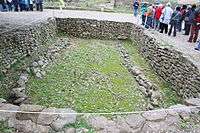
The Early Helladic II period came to an end at Lerna with the destruction of the "House of the Tiles", a corridor house.[13] The nature of the destruction of EHII sites was at first attributed to an invasion of Greeks and/or Indo-Europeans during the Early Helladic III period (or EHIII);[14] however, this is no longer maintained given the lack of uniformity in the destruction of EHII sites and the presence of EHII–EHIII/MH continuity in settlements such as Lithares, Phlius, Manika, etc.[15] Furthermore, the presence of "new/intrusive" cultural elements such as apsidal houses, terracotta anchors, shaft-hole hammer-axes, ritual tumuli, and intramural burials precede the EHIII period in Greece and are in actuality attributed to indigenous developments (i.e. terracotta anchors from Boeotia; ritual tumuli from Ayia Sophia in Neolithic Thessaly), as well as continuous contacts during the EHII–MH period between mainland Greece and various areas such as western Asia Minor, the Cyclades, Albania, and Dalmatia.[16] Changes in climate also appear to have contributed to the significant cultural transformations that occurred in Greece between the EHII period and the EHIII period (ca. 2200 BCE).[17]
Middle Helladic (MH)
In Greece, the Middle Helladic period (or MH) was a period of cultural retrogression, which first manifested in the preceding EHIII period.[5][18] The MH period is characterized by the wide-scale emergence of Minyan ware, which may be directly related to the people whom ancient Greek historians called Minyans; a group of monochrome burnished pottery from Middle Helladic sites was conventionally dubbed "Minyan" ware by Troy's discoverer Heinrich Schliemann.
Gray Minyan ware was first identified as the pottery introduced by a Middle Bronze Age migration;[19] the theory, however, is outdated as excavations at Lerna in the 1950s revealed the development of pottery styles to have been continuous (i.e. the fine gray burnished pottery of the EHIII Tiryns culture was the direct progenitor of Minyan ware).[20] In general, painted pottery decors are rectilinear and abstract until Middle Helladic III, when Cycladic and Minoan influences inspired a variety of curvilinear and even representational motifs.
The Middle Helladic period corresponds in time to the Middle Kingdom of Egypt. Settlements draw more closely together and tend to be sited on hilltops. Middle Helladic sites are located throughout the Peloponnese and central Greece (including sites in the interior of Aetolia such as Thermon) as far north as the Spercheios River valley. Malthi in Messenia and Lerna V are the only Middle Helladic sites to have been thoroughly excavated.
Late Helladic (LH)
The Late Helladic period (or LH) is the time when Mycenaean Greece flourished, under new influences from Minoan Crete and the Cyclades. Those who made LH pottery sometimes inscribed their work with a syllabic script, Linear B, which has been deciphered as Greek. LH is divided into LHI, LHII, and LHIII; of which LHI and LHII overlap Late Minoan ware and LHIII overtakes it. LHIII is further subdivided into LHIIIA, LHIIIB, and LHIIIC. The table below provides the approximate dates of the Late Helladic phases (LH) on the Greek mainland.

| Period | Approximate Date |
|---|---|
| LHIA | 1550–1500 BC |
| LHIB | 1500–1450 BC |
| LHII | 1450–1400 BC |
| LHIIIA1 | 1400–1350 BC |
| LHIIIA2 | 1350–1300 BC |
| LHIIIB1 | 1300–1230 BC |
| LHIIIB2 | 1230–1190 BC |
| LHIIIC (Early) | 1190–1130 BC |
| LHIIIC (Middle) | 1130–1090 BC |
| LHIIIC (Late) | 1090–1060 BC |
| Sub-Mycenean | 1060–1000 BC |
| Proto-Geometric | 1000 BC |
Late Helladic I (LHI)
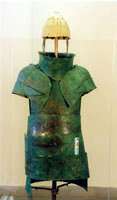
The LHI pottery is known from the fill of the Shaft Graves of Lerna and the settlements of Voroulia and Nichoria (Messenia), Ayios Stephanos, (Laconia) and Korakou. Furumark divided the LH in phases A and B, but Furumark's LHIB has been reassigned to LHIIA by Oliver Dickinson. Some recent C-14 dates from the Tsoungiza site north of Mycenae indicate LHI there was dated to between 1675/1650 and 1600/1550 BCE, which is earlier than the assigned pottery dates by about 100 years. The Thera eruption also occurred during LHI (and LCI and LMIA), variously dated within the 1650–1625 BCE span.
Not found at Thera, but extant in late LHI from Messenia, and therefore likely commencing after the eruption, is a material culture known as "Peloponnesian LHI".[21] This is characterised by "tall funnel-like Keftiu cups of Type III"; "small closed shapes such as squat jugs decorated with hatched loops ('rackets') or simplified spirals"; "dark-on-light lustrous-painted motifs", which "include small neat types of simple linked spiral such as varieties of hook-spiral or wave-spiral (with or without small dots in the field), forms of the hatched loop and double-axe, and accessorial rows of small dots and single or double wavy lines"; also, the "ripple pattern" on "Keftiu" cups. These local innovations continued into the LHIIA styles throughout the mainland.
Late Helladic II (LHII)
The description of the LHIIA is mainly based on the material from Kourakou East Alley. Domestic and Palatial shapes are distinguished. There are strong links between LHIIA and LMIB. LHIIB began before the end of LMIB, and sees a lessening of Cretan influences. Pure LHIIB assemblages are rare and originate from Tiryns, Asine and Korakou. C-14 dates from Tsoungiza indicate LHII was dated to between 1600/1550 and 1435/1405 BCE, the start of which is earlier than the assigned pottery date by about 100 years, but the end of which nearly corresponds to the pottery phase. In Egypt, both periods of LHII correspond with the beginning of its "Imperial" period, from Hatshepsut to Tuthmosis III (r. 1479–1425 BCE).
Late Helladic III (LHIII)
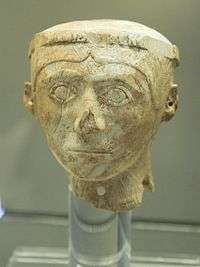
LHIII and LMIII are contemporary. Toward LMIIIB, non-Helladic ware from the Aegean ceases to be homogeneous; insofar as LMIIIB differs from Helladic, it should at most be considered a "sub-Minoan" variant of LHIIIB.
The uniform and widely spread LHIIIA:1 pottery was defined by the material from the Ramp house at Mycenae, the palace at Thebes (now dated to LHIIIA:2 or LHIIIB by most researchers) and Triada at Rhodes. There is material from Asine, Athens (wells), Sparta (Menelaion), Nichoria and the 'Atreus Bothros', rubbish sealed under the Dromos of the Treasury of Atreus at Mycenae as well. C-14 dates from Tsoungiza indicate LHIIIA:1 should be more nearly 1435/1406 to 1390/1370 BCE, slightly earlier than the pottery phase, but by less than 50 years. LHIIIA:1 ware has also been found in Maşat Höyük in Hittite Anatolia.[22]
The LHIIIA:2 pottery marks a Mycenaean expansion covering most of the Eastern Mediterranean. There are many new shapes. The motifs of the painted pottery continue from LHIIIA:1 but show a great deal of standardization. In Egypt, the Amarna site contains LHIIIA:1 ware during the reign of Amenhotep III and LHIIIA:2 ware during that of his son Akhenaten; it also has the barest beginnings of LHIIIB. LHIIIA:2 ware is in the Uluburun shipwreck, which sank in the 14th century BCE. Again, Tsoungiza dates are earlier, 1390/1370 to 1360/1325 BCE; but LHIIIA:2 ware also exists in a burn layer of Miletus which likely occurred early in the reign of Mursili II and therefore some years prior to Mursili's eclipse in 1312 BCE. The transition period between IIIA and IIIB begins after 1320 BCE, but not long after (Cemal Pulak thinks before 1295 BCE).
The definition of the LHIIIB by Furumark was mainly based on grave finds and the settlement material from Zygouries. It has been divided into two sub-phases by Elizabeth B. French, based on the finds from Mycenae and the West wall at Tiryns. LHIIIB:2 assemblages are sparse, as painted pottery is rare in tombs and many settlements of this period ended by destruction, leaving few complete pots behind.
LHIIIB pottery is associated in the Greek mainland palaces with the Linear B archives. (Linear B had been in use in Crete since Late Minoan II.) Pulak's proposed LHIIIA/B boundary would make LHIIIB contemporary in Anatolia with the resurgent Hittites following Mursili's eclipse; in Egypt with the 19th Dynasty, also known as the Ramessides; and in northern Mesopotamia with Assyria's ascendancy over Mitanni. The end of LHIIIB is associated with the destruction of Ugarit, whose ruins contain the last of that pottery. The Tsoungiza date for the end of LHIIIB is 1200/1190 BCE. The beginning of LHIIIC, therefore, is now commonly set into the reign of Queen Twosret. The LHIIIC has been divided into LHIIIC:1 and LHIIIC:2 by Furumark, based on materials from tombs in Mycenae, Asine, Kephalonia, and Rhodes. In the 1960s, the excavations of the citadel at Mycenae and of Lefkandi in Euboea yielded stratified material revealing significant regional variation in LHIIIC, especially in the later phases. Late LHIIIC pottery is found in Troy VIIa and a few pieces in Tarsus. It was also made locally in the Philistine settlements of Ashdod, Ashkelon, Ekron, Gath, and Gaza.
Fortified settlements
During the Helladic period, a number of major advances were developed including fortified urban settlements with monumental buildings such as corridor houses, which may prove the existence of complex societies organized by an elite or at least achieving corporate, proto-city state form.[7][23] One of these settlements was Manika, located in Euboea, dated to the Early Helladic period II (2800–2200 BC). The settlement covered an area of 70-80 hectares, was inhabited by 6,000–15,000 people, and was one of the largest settlements of the Bronze Age in Greece.[7][24]
Another settlement was Lerna in the Argolid region, which was perhaps the most important and wealthiest of Early Helladic sites.[25] The settlement has a monumental building known as the House of the Tiles, a "corridor house",[26] notable for several architectural features that were advanced for its time, such as its roof being covered by baked tiles, which gave the building its name.[27] The structure dates to the Early Helladic II period (2500–2300 BC) and is sometimes interpreted as the dwelling of an elite member of the community, a proto-palace, or an administrative center. Alternatively, it has also been considered to be a communal structure or the common property of the townspeople.[28] The exact functions of the building remain unknown due to a lack of small finds indicating the specific uses of the building.[28] The house had a stairway leading to a second story, and was protected by a tiled roof.[29] Debris found at the site contained thousands of terracotta tiles having fallen from the roof.[30] Although such roofs were also found in the Early Helladic site of Akovitika,[31] and later in the Mycenaean towns of Gla and Midea,[32] they only became common in Greek architecture in the 7th century BC.[33] The walls of the House of the Tiles were constructed with sun-dried bricks on stone socles.[27]
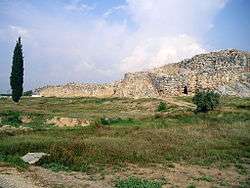
Other fortified settlements include Tiryns, which covered an area of 5.9 hectares sustaining 1,180–1,770 people,[24] and had a large tiled two-storeyed "round house" (or Rundbau) with a diameter of 28 m on the upper citadel. It may have served as a palace or temple or perhaps it was a communal granary.[34][35] Other sites include Ayia Irini, which covered an area of 1 hectare and had a population of perhaps up to 1,250,[36] Eutresis covering 8 hectares with an estimated population of 1,600–2,400, Thebes covering 20 hectares with a population of 4,000–6,000,[24] Lefkandi (unknown in size and population), and Kolonna (or Aegina), a densely populated settlement with impressive fortifications, monumental stone buildings and sophisticated town planning.
Already before 2500–2400 BC, Kolonna experienced remarkable economic growth and had its own administrative "Corridor House", the so-called "Haus am Felsrand".[37] During the phase Aegina III 2400–2300 BC, which corresponds to the transition phase Lefkandi I-Kastri, the evidence of the economic structure and administrative and social organization of the community become more clear.[37] The "White House" (Weisses Haus; 165 square metres) constitutes the monumental community building that succeeds the "Haus am Felsrand", which had the same function.[37] Kolonna may constitute the Aegean's first state as it appears to be the earliest ranked society in the area outside Minoan Crete and perhaps a political center in the Middle Helladic period where it achieved state-level after the Minoans but before the Mycenaeans.[38]
Population
Multivariate analyses of craniometric data derived from Helladic skeletal material indicate a strong morphological homogeneity in the Bronze Age osteological record, disproving the influx of foreign populations between the Early Helladic and Middle Helladic periods; ultimately, the Bronze Age inhabitants of mainland Greece (including the Mycenaeans) represent a single and homogeneous population of Mediterranean provenance.[39]
See also
References
Citations
- 1 2 3 4 5 6 7 8 9 10 11 Bury and Meiggs 1975, p. 6
- ↑ Bury and Meiggs 1975, p. 5
- ↑ "The Bronze Age on the Greek Mainland: Early Bronze Age – Early Helladic I". Athens: Foundation of the Hellenic World. 1999–2000.
- ↑ "The Bronze Age on the Greek Mainland: Early Bronze Age – Early Helladic II". Athens: Foundation of the Hellenic World. 1999–2000.
- 1 2 "The Bronze Age on the Greek Mainland: Early Bronze Age – Early Helladic III". Athens: Foundation of the Hellenic World. 1999–2000.
- 1 2 3 4 5 6 7 8 MacSweeney 2004, Table 1. Population estimates for Aegean sites in EB II, p. 57; MacSweeney dates the Early Bronze II period (or EB II) to circa 2800–2200 BC (see p. 53).
- 1 2 3 Sampson 1987, p. 19.
- ↑ http://www.diva-portal.org/smash/get/diva2:169578/FULLTEXT01.pdf
- ↑ Pullen 2008, p. 20; van Andels & Runnels 1988, "The transition to the Early Bronze Age", pp. 238–240; French 1973, p. 53.
- 1 2 Pullen 2008, pp. 21–22.
- ↑ Pullen 2008, pp. 24–26; Whittaker 2014, p. 49: "The second half of the Early Helladic period is characterized by monumental architecture and fortifications, a hierarchical social organization, widespread metallurgy and lively contacts with other parts of the Aegean."
- ↑ Pullen 2008, pp. 27–28.
- ↑ Pullen 2008, pp. 36, 43 (Endnote #22): "A corridor house is a large, two-story building consisting of two or more large rooms flanked by narrow corridors on the sides. Some of those corridors held staircases; others were used for storage."
- ↑ Caskey 1960, pp. 285–303.
- ↑ Pullen 2008, p. 36; Forsén 1992, pp. 251–253.
- ↑ Pullen 2008, p. 36; Forsén 1992, pp. 253–257.
- ↑ Pullen 2008, p. 36.
- ↑ "The Bronze Age on the Greek Mainland: Middle Bronze Age – Introduction". Athens: Foundation of the Hellenic World. 1999–2000.
- ↑ Mellaart 1958, pp. 9–33.
- ↑ Pullen 2008, p. 40; French 1973, pp. 51–57; Caskey 1960, pp. 285–303.
- ↑ Lolos 1990, pp. 51–56.
- ↑ Kuniholm 1998, pp. 3–4.
- ↑ Bintliff 2012, p. 107: "Taken together, the Mainland Early Helladic Corridor Houses, Anatolian Troy, the Northeast Aegean fortified villages, and perhaps also Manika, may well evidence complex societies, either organized by an elite, or at least achieving corporate, proto-city state form."
- 1 2 3 MacSweeney 2004, p. 57 (Table 1. Population estimates for Aegean sites in EB II).
- ↑ Bryce 2006, p. 47: "Lerna in the Argolid region was probably the most important and the wealthiest of all Early Helladic II sites. Founded in the Neoiithic period (represented by Levels I and II on the site), it was abandoned at the end of this period and was subsequently reoccupied at the beginning of Early Helldaic II (Level III)."
- ↑ Shaw 1987, pp. 59–79.
- 1 2 Overbeck 1963, p. 5.
- 1 2 Overbeck 1963, p. 6.
- ↑ Overbeck 1963, p. 5; Shaw 1987, p. 59.
- ↑ Caskey 1968, p. 314.
- ↑ Shaw 1987, p. 72.
- ↑ Shear 2000, pp. 133–134.
- ↑ Wikander 1990, p. 285.
- ↑ Chapman 2005, p. 92; Hornblower, Spawforth & Eidinow 2012, "Tiryns", p. 1486.
- ↑ Tiryns. Reconstructed Groundplan of the Circular Building (Rundbau). Early Helladic II.
- ↑ Weisman, Stefanie (2008). "An Analysis of the Late Bronze Age Site of Ayia Irini, Keos" (PDF). Institute of Fine Arts.
- 1 2 3 "The Bronze Age on the Greek Mainland: Early Bronze Age – Aegina". Athens: Foundation of the Hellenic World. 1999–2000.
- ↑ Chapman 2005, p. 93.
- ↑ Forsén 1992, p. 247; Xirotiris 1980, p. 209; Musgrave & Evans 1981, pp. 75, 80.
Sources
- Bintliff, John (2012). The Complete Archaeology of Greece: From Hunter-Gatherers to the 20th Century A.D. Malden, MA: John Wiley & Sons. ISBN 978-1-40-515419-2.
- Bryce, Trevor (2006). The Trojans and their Neighbours. New York, NY: Routledge. ISBN 978-0-41-534955-0.
- Bury, J. B.; Meiggs, Russell (1975). A History of Greece (Fourth Edition). London: MacMillan Press. ISBN 0-333-15492-4.
- Caskey, John L. (July–September 1960). "The Early Helladic Period in the Argolid". Hesperia. The American School of Classical Studies at Athens. 29 (3): 285–303. doi:10.2307/147199.
- Caskey, John L. (1968). "Lerna in the Early Bronze Age". American Journal of Archaeology. 72: 313–316. doi:10.2307/503823.
- Chapman, Robert (2005). "Changing Social Relations in the Mediterranean Copper and Bronze Ages". In Blake, Emma; Knapp, A. Bernard. The Archaeology of Mediterranean Prehistory. Oxford and Malden: Blackwell Publishing. pp. 77–101. ISBN 978-1-40-513724-9.
- Forsén, Jeannette (1992). The Twilight of the Early Helladics. Partille, Sweden: Paul Aströms Förlag. ISBN 91-7081-031-1.
- French, D.M. (1973). "Migrations and 'Minyan' pottery in western Anatolia and the Aegean". In Crossland, R.A.; Birchall, Ann. Bronze Age Migrations in the Aegean. Park Ridge, NJ: Noyes Press. pp. 51–57.
- Hornblower, Simon; Spawforth, Antony; Eidinow, Esther (2012) [1949]. The Oxford Classical Dictionary (4th ed.). Oxford: Oxford University Press. ISBN 978-0-19-954556-8.
- Kuniholm, Peter Ian (1998). "Aegean Dendrochronology Project December 1996 Progress Report" (PDF). Cornell Tree-Ring Laboratory. Ithaca, NY: Cornell University: 1–7.
- Lolos, Y.G. (1990). "On the Late Helladic I of Akrotiri, Thera". In Hardy, D.A.; Renfrew, A.C. Thera and the Aegean World III. Volume Three: Chronology – Proceedings of the Third International Congress, Santorini, Greece, 3–9 September 1989. London: Thera Foundation. pp. 51–56.
- MacSweeney, Naoise (2004). "Social Complexity and Population: A Study in the Early Bronze Age Aegean". Papers from the Institute of Archaeology. 15: 52–65. doi:10.5334/256.
- Mellaart, James (January 1958). "The End of the Early Bronze Age in Anatolia and the Aegean". American Journal of Archaeology. Archaeological Institute of America. 62 (1): 9–33. doi:10.2307/500459.
- Musgrave, Jonathan H.; Evans, Suzanne P. (1981). "By Strangers Honor'd: A Statistical Study of Ancient Crania from Crete, Mainland Crete, Cyprus, Israel, and Egypt". Journal of Mediterranean Anthropology and Archaeology. 1: 50–107.
- Overbeck, John Clarence (1963). A Study of Early Helladic Architecture. University of Cincinnati.
- Pullen, Daniel (2008). "The Early Bronze Age in Greece". In Shelmerdine, Cynthia W. The Cambridge Companion to the Aegean Bronze Age. Cambridge and New York: Cambridge University Press. pp. 19–46. ISBN 978-0-521-81444-7.
- Sampson, Adamantios (1987). "The Early Helladic Graves of Manika: Contribution to the Socioeconomic Conditions of the Early Bronze Age" (PDF). Aegaeum. 1: 19–28. Archived from the original (PDF) on 4 March 2016.
- Shaw, Joseph W. (1987). "The Early Helladic II Corridor House: Development and Form". American Journal of Archaeology. Archaeological Institute of America. 91 (1): 59–79. doi:10.2307/505457.
- Shear, Ione Mylonas (January 2000). "Excavations on the Acropolis of Midea: Results of the Greek–Swedish Excavations under the Direction of Katie Demakopoulou and Paul Åström". American Journal of Archaeology. 104 (1): 133–134.
- van Andels, Tjeerd H.; Runnels, Curtis N. (1988). "An Essay on the 'Emergence of Civilization' in the Aegean World". Antiquity. Antiquity Publications Limited. 62 (235): 234–247. Archived from the original on 2013-10-14.
- Whittaker, Helène (2014). Religion and Society in Middle Bronze Age Greece. New York, NY: Cambridge University Press. ISBN 978-1-10-704987-1.
- Wikander, Örjan (January–March 1990). "Archaic Roof Tiles the First Generations". Hesperia. 59 (1): 285–290. doi:10.2307/148143.
- Xirotiris, Nicholas I. (Spring–Summer 1980). "The Indo-Europeans in Greece: An Anthropological Approach to the Population of Bronze Age Greece". Journal of Indo-European Studies. 8 (1–2): 201–210.
Further reading
- Weiberg, Erika (2007). Thinking the Bronze Age: Life and Death in Early Helladic Greece (Boreas: Uppsala Studies in Ancient Mediterranean and Near Eastern Civilizations 29) (PDF). Uppsala: Acta Universitatis Upsaliensis. ISBN 978-91-554-6782-1.
External links
- "The Bronze Age on the Greek Mainland". Athens: Foundation of the Hellenic World. 1999–2000.
- Horejs, Barbara; Pavúk, Peter, eds. (2007). "The Aegeo-Balkan Prehistory Project". The Aegeo-Balkan Prehistory Team.
- Rutter, Jeremy B. "Prehistoric Archeology of the Aegean". Hanover, NH: Dartmouth College. Archived from the original on 1 January 2009.

